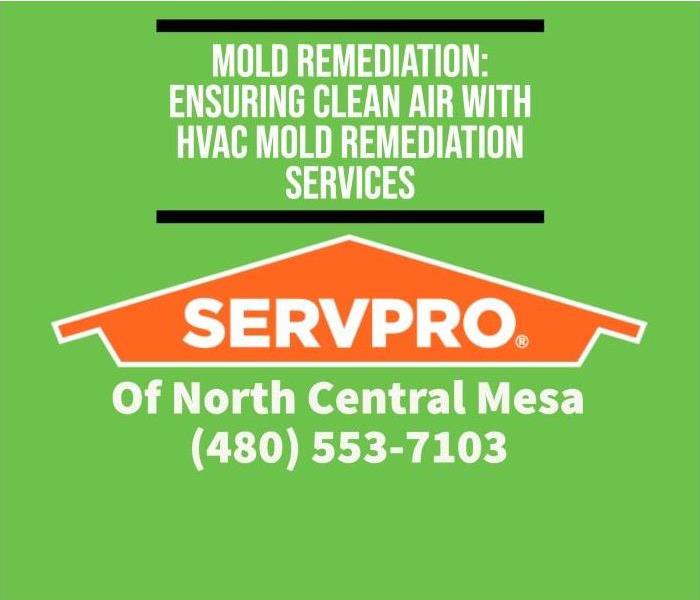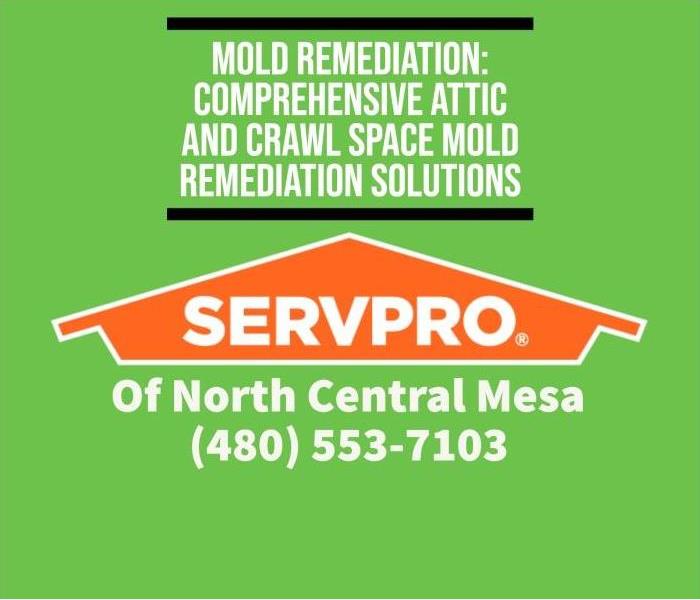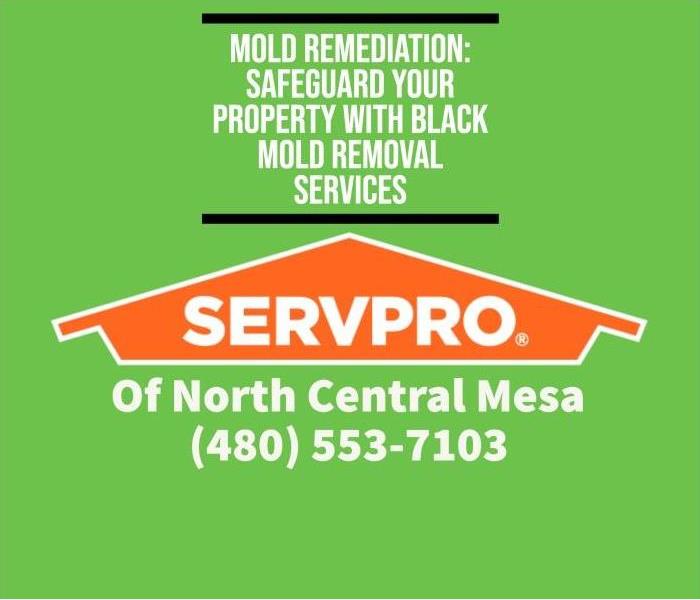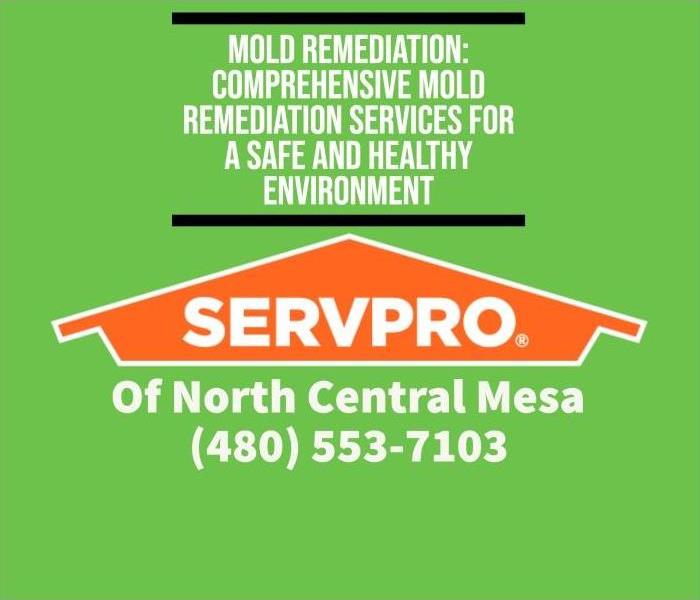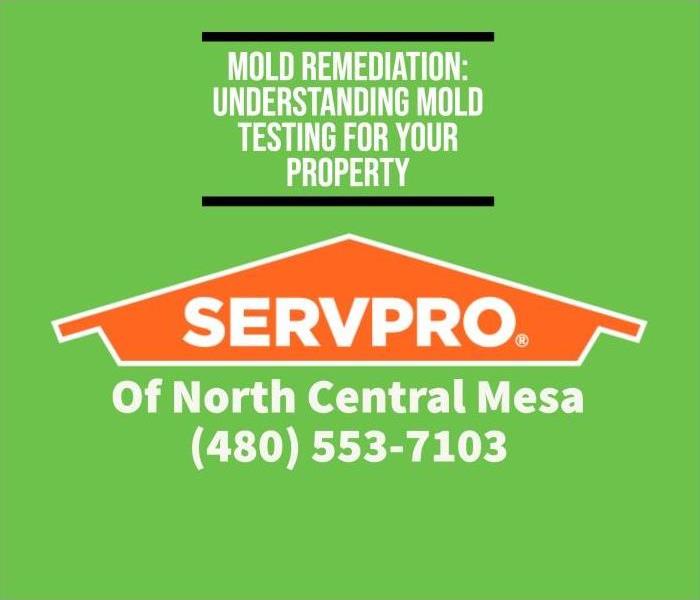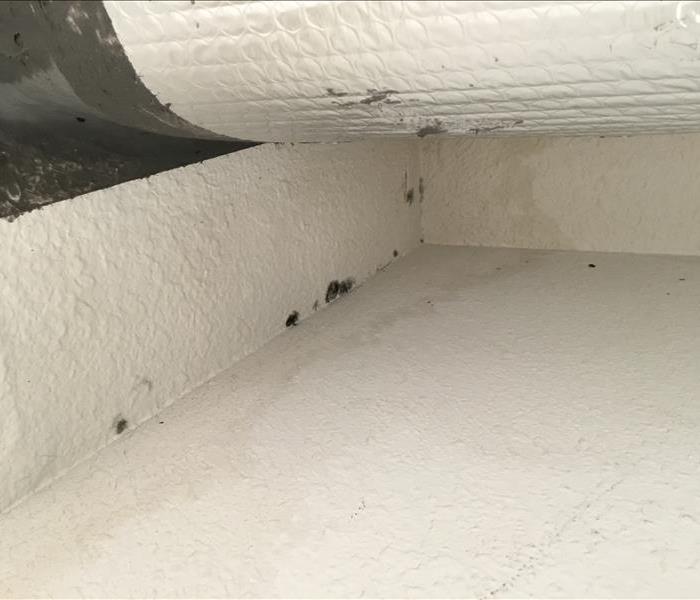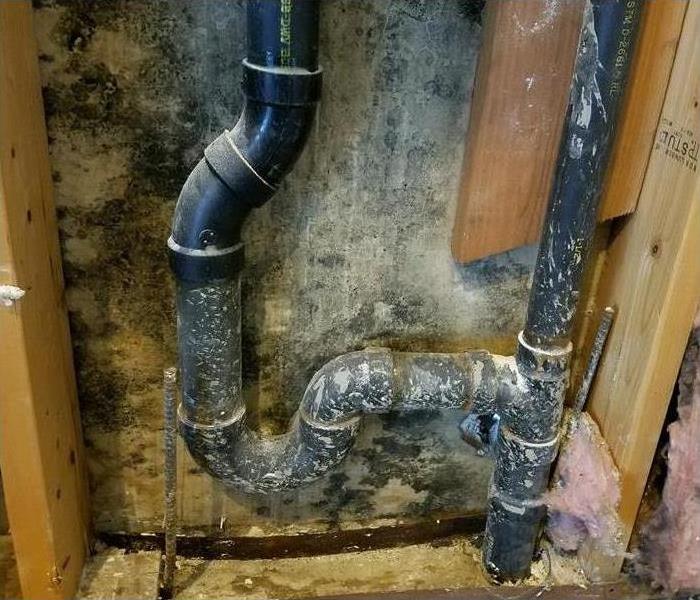Recent Mold Remediation Posts
Mold Remediation: Ensuring Clean Air with HVAC Mold Remediation Services
4/5/2023 (Permalink)
Mold Remediation: Ensuring Clean Air with HVAC Mold Remediation Services
Mold growth in HVAC systems can lead to poor indoor air quality and pose health risks to building occupants. SERVPRO of North Central Mesa offers expert HVAC mold remediation services to ensure a safe and healthy environment for property owners and their occupants. In this blog post, we will discuss how mold grows in HVAC systems, how it is removed, and how to prevent HVAC mold growth. Additionally, we will provide a FAQ section to answer further questions related to HVAC mold remediation.
How Does Mold Grow in HVAC Systems?
Mold growth in HVAC systems is primarily caused by excess moisture and organic materials, which provide a suitable environment for mold to thrive. Common sources of mold growth in HVAC systems include:
- Condensation: High humidity levels and temperature fluctuations can lead to condensation within the HVAC system, providing moisture for mold growth.
- Leaks: Leaking ductwork or HVAC components can introduce moisture into the system, promoting mold growth.
- Dust and debris: Accumulation of dust and debris in the HVAC system can provide organic material for mold to feed on.
How is Mold Removed from HVAC Systems?
HVAC mold remediation involves several key steps to ensure thorough and effective removal of mold and prevention of future growth.
Inspection
A thorough inspection of the HVAC system is conducted to identify the extent of mold contamination and the source of the moisture problem. This information helps to develop a comprehensive remediation plan tailored to the specific needs of the property.
Containment
Containment is essential to prevent the spread of mold spores during the remediation process. Affected areas are sealed off using plastic sheeting and negative air pressure to ensure mold spores do not contaminate other parts of the property.
Mold-contaminated components of the HVAC system are carefully cleaned or replaced, depending on the severity of the contamination. Specialized equipment, such as HEPA vacuums and air scrubbers, may be used to remove mold spores from surfaces and the air.
Cleaning and Disinfection (H3): After mold removal, all surfaces and components within the HVAC system are thoroughly cleaned and disinfected to eliminate any remaining mold spores and prevent future growth. This process may involve the use of specialized cleaning agents and HEPA-filtered vacuums.
Drying and Dehumidification
To prevent future mold growth, it is crucial to address the underlying moisture problem. This may involve repairing leaks, drying wet materials, and using dehumidifiers to maintain appropriate humidity levels within the property.
System Maintenance
Regular maintenance of the HVAC system, including filter replacement and duct cleaning, can help prevent mold growth and ensure optimal system performance.
How Can HVAC Mold Growth Be Prevented?
Preventing mold growth in HVAC systems involves controlling moisture levels and maintaining proper system maintenance. Here are some tips for preventing HVAC mold growth:
- Regular maintenance: Schedule regular HVAC system maintenance, including filter replacement, coil cleaning, and ductwork inspection, to keep the system clean and functioning efficiently.
- Monitor humidity levels: Maintain indoor humidity levels between 30% and 50% to minimize the risk of condensation and mold growth.
- Inspect for leaks: Regularly inspect your HVAC system for leaks and promptly repair any issues found.
- Improve ventilation: Ensure adequate ventilation in your property to help control humidity levels and prevent moisture buildup.
Q: How do I know if there is mold in my HVAC system?
A: Signs of mold in your HVAC system may include a musty odor, unexplained allergic symptoms or respiratory issues, and visible mold growth on or around air vents and ductwork.
Q: Can I clean mold from my HVAC system myself?
A: DIY mold removal in HVAC systems is not recommended due to the potential health risks and the complexity of the system. Hiring certified professionals with the necessary training, experience, and equipment ensures safe and effective mold remediation.
Q: How much does HVAC mold remediation cost?
A: The cost of HVAC mold remediation varies depending on the severity of the mold issue and the size of the affected area. If you are in the Mesa, AZ area, Contact SERVPRO of North Central Mesa for a detailed estimate based on your specific needs.
Q: How long does HVAC mold remediation take?
A: The duration of HVAC mold remediation depends on the extent of the mold contamination and the size of the affected area. Smaller projects may take just a few days, while larger or more complex remediation can take several weeks.
Q: Can mold in my HVAC system affect my indoor air quality?
A: Yes, mold growth in your HVAC system can negatively impact your indoor air quality, as mold spores can be circulated throughout your property via the air ducts. This can lead to increased allergic symptoms and respiratory issues for building occupants.
HVAC mold remediation is essential for maintaining a safe and healthy environment for property owners and occupants. SERVPRO of North Central Mesa offers comprehensive HVAC mold remediation services, effectively addressing mold issues in your HVAC system and ensuring optimal indoor air quality. If you suspect mold in your HVAC system, contact our team of certified professionals to schedule an assessment and discuss your specific needs.
Mold Remediation: Comprehensive Attic and Crawl Space Mold Remediation Solutions
4/5/2023 (Permalink)
Mold growth in attics and crawl spaces can pose significant health risks and property damage if not promptly addressed. SERVPRO of North Central Mesa offers expert attic and crawl space mold remediation services to ensure a safe and healthy environment for property owners and their occupants. In this blog post, we will discuss the causes of mold growth in attics and crawl spaces, how mold is removed from these areas, and the risks associated with mold exposure. Additionally, we will provide a FAQ section to answer further questions related to attic and crawl space mold remediation.
What Causes Mold in Attics and Crawl Spaces?
Mold growth in attics and crawl spaces is primarily caused by excess moisture and inadequate ventilation. Common causes of moisture in these areas include:
Roof leaks
Damaged or missing shingles, improper flashing installation, and ice dams can lead to water intrusion in the attic, creating a breeding ground for mold.
Plumbing leaks:
Leaking pipes in the walls or ceiling can cause moisture buildup in the attic or crawl space, promoting mold growth.
Condensation
High humidity levels and poor ventilation can lead to condensation, particularly on cool surfaces in the attic or crawl space, providing an ideal environment for mold.
Inadequate vapor barriers
Improperly installed or missing vapor barriers in crawl spaces can allow ground moisture to enter and encourage mold growth.
How is Mold Removed from Attics and Crawl Spaces?
Mold remediation in attics and crawl spaces involves several key steps to ensure thorough and effective removal of mold and prevention of future growth.
Assessment
A thorough inspection is conducted to identify the extent of the mold contamination, the types of mold present, and the source of the moisture problem. This information helps to develop a comprehensive remediation plan tailored to the specific needs of the property.
Containment
Containment is essential to prevent the spread of mold spores during the remediation process. Affected areas are sealed off using plastic sheeting and negative air pressure to ensure mold spores do not contaminate other parts of the property.
Mold Removal
Mold removal involves the physical removal of mold-contaminated materials. This may include the use of specialized equipment, such as HEPA vacuums and air scrubbers, to remove mold spores from surfaces and the air. In some cases, porous materials, like insulation, may need to be discarded and replaced due to extensive contamination.
Cleaning and Disinfection
After mold removal, all surfaces and belongings in the affected area are thoroughly cleaned and disinfected to eliminate any remaining mold spores and prevent future growth. This process may involve the use of specialized cleaning agents and HEPA-filtered vacuums.
Drying and Dehumidification (H3): To prevent future mold growth, it is crucial to address the underlying moisture problem. This may involve repairing leaks, drying wet materials, and using dehumidifiers to maintain appropriate humidity levels within the property.
Restoration
Once the mold remediation process is complete, the property is restored to its pre-mold condition. This may include replacing damaged materials, repainting walls, or reinstalling insulation.
What are the Risks of Mold Exposure?
Mold exposure can cause various health problems, particularly for individuals with pre-existing respiratory conditions or compromised immune systems. Common health risks associated with mold exposure include:
Allergic reactions
Mold exposure can trigger allergic symptoms such as sneezing, runny nose, itchy eyes, and skin irritation.
- Respiratory issues: Mold spores can cause respiratory problems, including coughing, wheezing, and difficulty breathing, especially in individuals with asthma or other respiratory conditions.
- Infections: In rare cases, mold exposure can lead to fungal infections, particularly in individuals with weakened immune systems.
- Long-term health effects: Prolonged mold exposure may increase the risk of developing chronic respiratory conditions or exacerbate pre-existing health issues.
Attic and Crawl Space Mold Remediation Solutions FAQs:
Q: How can I prevent mold growth in my attic and crawl space?
A: Preventing mold growth in attics and crawl spaces involves controlling moisture levels and ensuring proper ventilation. Regularly inspect your property for leaks, promptly repair any water damage, install vapor barriers in crawl spaces, and ensure your attic has adequate ventilation.
Q: How do I know if I have mold in my attic or crawl space?
A: Signs of mold in attics and crawl spaces include visible mold growth, a musty odor, unexplained allergic symptoms or respiratory issues, and a history of water damage or moisture problems in your property.
Q: How much does attic and crawl space mold remediation cost?
A: The cost of attic and crawl space mold remediation varies depending on the severity of the mold issue and the size of the affected area. Contact SERVPRO of North Central Mesa for a detailed estimate based on your specific needs.
Q: Can I remove mold from my attic or crawl space myself?
A: DIY mold removal is not recommended, as it can be dangerous and may not effectively address the issue. Certified professionals have the necessary knowledge, experience, and equipment to safely and effectively remove mold and prevent future growth.
Q: How long does attic and crawl space mold remediation take?
A: The duration of attic and crawl space mold remediation depends on the extent of the mold contamination and the size of the affected area. Smaller projects may take just a few days, while larger or more complex remediation can take several weeks.
Attic and crawl space mold remediation is essential for ensuring the safety and well-being of property owners and occupants. SERVPRO of North Central Mesa offers comprehensive mold remediation services, effectively addressing your mold concerns and restoring a healthy environment. If you suspect mold issues in your attic or crawl space, contact our team of certified professionals to schedule an assessment and discuss your specific needs.
Mold Remediation: Safeguard Your Property with Black Mold Removal Services
4/5/2023 (Permalink)
Black mold, also known as Stachybotrys chartarum, is a particularly concerning type of mold that can cause significant health issues and property damage if not addressed promptly. SERVPRO of North Central Mesa offers expert black mold removal services to ensure the safety and well-being of property owners and their occupants. In this blog post, we will discuss what black mold is, why it's dangerous, and how it's removed. We will also provide a FAQ section to answer additional questions related to black mold removal.
What is Black Mold?
Black mold is a toxic mold species that is greenish-black in color and often has a musty odor. It typically grows on cellulose-rich materials such as wood, drywall, and paper, particularly in damp or humid conditions. Black mold produces mycotoxins, which are toxic compounds that can cause a range of health problems when inhaled or ingested.
Why is Black Mold Dangerous?
Black mold poses significant health risks due to the production of mycotoxins. Exposure to these toxins can cause a variety of symptoms, including respiratory issues, allergic reactions, skin irritation, and even neurological problems in severe cases. Black mold can also cause substantial property damage if left untreated, as it can weaken the structural integrity of building materials.
Black mold removal follows a similar process to general mold remediation but requires extra precautions due to the toxic nature of the mold. Certified professionals should handle black mold removal to ensure the safety of all parties involved.
Assessment
A thorough assessment is conducted to determine the extent of the black mold contamination, the types of materials affected, and the source of the moisture problem. This information is used to develop a comprehensive black mold removal plan tailored to the specific needs of the property.
Containment
During black mold removal, containment is crucial to prevent the spread of toxic spores. Affected areas are sealed off using plastic sheeting and negative air pressure to keep mold spores from contaminating other parts of the property.
Personal Protective Equipment
Due to the toxic nature of black mold, professionals wear appropriate personal protective equipment (PPE) during the removal process. This typically includes full-body suits, gloves, goggles, and respirators with HEPA filters.
Mold Removal
Black mold-contaminated materials are carefully removed and disposed of according to local regulations. Non-porous surfaces can be cleaned using specialized cleaning agents, while porous materials may need to be replaced.
Cleaning and Disinfection
Once the black mold has been removed, all surfaces and belongings in the affected area are thoroughly cleaned and disinfected to eliminate any remaining spores and toxins.
Drying and Dehumidification
Addressing the underlying moisture problem is essential to prevent future black mold growth. This may involve repairing leaks, drying wet materials, and using dehumidifiers to maintain appropriate humidity levels within the property.
Restoration
After the black mold removal process is complete, the property is restored to its pre-mold condition. This may include replacing damaged materials, repainting walls, or reinstalling carpets.
FAQs
Q: How can I prevent black mold growth in my property?
A: Preventing black mold growth involves controlling moisture levels and maintaining proper ventilation. Regularly inspect your property for leaks, promptly repair any water damage, use dehumidifiers in high-humidity areas, and ensure your HVAC system is functioning efficiently.
Q: How long does black mold removal take ?
A: The duration of black mold removal depends on the extent of the contamination and the size of the affected area. Smaller projects may take just a few days, while larger or more complex removals can take several weeks.
A: The cost of black mold removal varies depending on the severity of the mold issue and the size of the affected area. Contact SERVPRO of North Central Mesa for a detailed estimate based on your specific needs.
Q: Can I remove black mold myself?
A: DIY black mold removal is strongly discouraged due to the health risks associated with exposure to toxic mold spores. It is crucial to hire certified professionals with the necessary training, experience, and equipment to safely and effectively remove black mold.
Q: What are the signs of black mold in my property?
A: Signs of black mold may include visible mold growth with a greenish-black appearance, a musty odor, and unexplained health issues such as respiratory problems or allergic reactions.
Black mold removal is a critical service for ensuring the safety and well-being of property owners and occupants. SERVPRO of North Central Mesa offers expert black mold removal services to effectively address your mold concerns and restore a healthy environment. If you suspect black mold in your home or business, contact our team of certified professionals to schedule an assessment and discuss your specific needs.
Mold Remediation: Comprehensive Mold Remediation Services for a Safe and Healthy Environment
4/5/2023 (Permalink)
Mold growth can pose significant risks to your property and health, making mold remediation a crucial service. SERVPRO of North Central Mesa offers expert mold remediation services, ensuring the safety and well-being of property owners and their occupants. In this blog post, we will discuss what mold remediation is, how it's done, and the steps involved in the process. We will also provide a FAQ section to answer additional questions related to mold remediation services.
Mold remediation is the process of removing and cleaning mold-contaminated materials from a property to restore a healthy environment. This includes identifying the source of the mold, containing and removing affected materials, and preventing future mold growth. Mold remediation is best performed by certified professionals who have the necessary training, expertise, and equipment to safely and effectively address mold issues.
How is Mold Remediation Done?
Mold remediation typically involves several key steps to ensure thorough and effective removal of mold and prevention of future growth.
Steps for Mold Remediation
Assessment
The first step in mold remediation is a thorough assessment of the property. This includes identifying the extent of the mold contamination, the types of mold present, and the source of the moisture problem. This information helps to develop a comprehensive remediation plan tailored to the specific needs of the property.
Containment
Containment is essential to prevent the spread of mold spores during the remediation process. Affected areas are sealed off using plastic sheeting and negative air pressure to ensure mold spores do not contaminate other parts of the property.
Mold Removal
Mold removal involves the physical removal of mold-contaminated materials. This may include the use of specialized equipment, such as HEPA vacuums and air scrubbers, to remove mold spores from surfaces and the air. In some cases, porous materials, like drywall and insulation, may need to be discarded and replaced due to extensive contamination.
Cleaning and Disinfection
After mold removal, all surfaces and belongings in the affected area are thoroughly cleaned and disinfected to eliminate any remaining mold spores and prevent future growth. This process may involve the use of specialized cleaning agents and HEPA-filtered vacuums.
Drying and Dehumidification
To prevent future mold growth, it is crucial to address the underlying moisture problem. This may involve repairing leaks, drying wet materials, and using dehumidifiers to maintain appropriate humidity levels within the property.
Restoration
Once the mold remediation process is complete, the property is restored to its pre-mold condition. This may include replacing damaged materials, repainting walls, or reinstalling carpets.
FAQs
Q: How long does mold remediation take?
A: The duration of mold remediation depends on the extent of the mold contamination and the size of the affected area. Smaller projects may take just a few days, while larger or more complex remediation can take several weeks.
Q: How much does mold remediation cost?
A: The cost of mold remediation varies depending on the severity of the mold issue and the size of the affected area. Contact SERVPRO of North Central Mesa for a detailed estimate based on your specific needs.
Q: Can I perform mold remediation myself?
A: DIY mold remediation is not recommended, as it can be dangerous and may not effectively address the issue. Certified professionals have the necessary knowledge, experience, and equipment to safely and effectively remove mold and prevent future growth. Attempting mold remediation without proper training and equipment can put your health at risk and may exacerbate the problem.
Q: Is mold remediation covered by insurance?
A: Mold remediation may be covered by insurance, depending on the cause of the mold and the specifics of your policy. It is important to review your insurance policy and contact your insurance provider for more information on coverage for mold remediation services.
Q: What are the signs that I need mold remediation?
A: Signs that you may need mold remediation include visible mold growth, a musty odor, unexplained allergic symptoms or respiratory issues, and a history of water damage or moisture problems in your property.
Mold remediation is essential for addressing mold issues and restoring a safe and healthy environment in your property. SERVPRO of North Central Mesa offers comprehensive mold remediation services, ensuring effective and long-lasting solutions to your mold concerns. If you suspect mold issues in your home or business, contact our team of certified professionals to schedule an assessment and discuss your specific needs.
Mold Remediation: Understanding Mold Testing for Your Property
4/5/2023 (Permalink)
Mold growth can have adverse effects on your property and your health, making mold remediation an essential service. SERVPRO of North Central Mesa is committed to providing homeowners and businesses with the information they need to understand mold testing and its benefits. This blog post covers the basics of mold testing, how it's done, and the benefits it can provide to ensure a safe and healthy environment. We will also provide a FAQ section to answer other common questions related to mold testing.
What is Mold Testing?
Mold testing is a process used to detect the presence of mold in a building or property. This procedure is often necessary when mold is suspected but not visible or when a building has experienced water damage. Mold testing helps to identify the type and extent of mold contamination, allowing for effective mold remediation strategies. Mold tests are performed by certified mold inspectors, ensuring accurate and reliable results.
Visual Inspection:
The first step in mold testing is a thorough visual inspection of the property. This inspection is done to identify any visible signs of mold growth, water damage, or moisture issues. The inspector will examine walls, ceilings, floors, crawlspaces, and ventilation systems for any signs of mold or conducive conditions.
Air sampling is a common method used to test for mold spores in the air. The inspector collects air samples from various locations within the property and sends them to a laboratory for analysis. This method helps determine the concentration of mold spores in the air and identify the specific types of mold present.
Surface Sampling:
Surface sampling involves collecting samples from surfaces suspected of harboring mold growth. This can be done using swabs, tape lifts, or bulk samples. These samples are then sent to a lab for microscopic analysis to confirm the presence of mold and identify the species.
Moisture and Humidity Measurements:
High humidity levels and moisture are key factors contributing to mold growth. During mold testing, inspectors measure the moisture content of materials and the relative humidity levels in the property. This information helps identify areas at risk for mold growth and guides the remediation process.
The Benefits of Mold Testing
Health and Safety:
Mold can cause a variety of health issues, especially for individuals with allergies, asthma, or weakened immune systems. Mold testing helps to identify and address mold issues early, reducing the risk of health problems and ensuring a safe environment for occupants.
Accurate Remediation:
Mold testing allows for targeted and efficient mold remediation. By identifying the specific types and locations of mold, remediation efforts can be focused on the areas that need it most. This ensures thorough and effective mold removal, preventing recurrence.
Prevent Property Damage:
Unchecked mold growth can cause significant property damage, weakening the structural integrity of your home or business. Mold testing helps to identify and address mold issues before they become severe, saving you time and money on repairs.
Maintain Property Value:
Mold issues can negatively impact the value of a property. By conducting mold testing and addressing any issues, you can maintain or even increase your property's value, making it more attractive to potential buyers.
FAQs
Q: How much does mold testing cost?
A: The cost of mold testing varies depending on the size of the property and the complexity of the testing required. Contact SERVPRO of North Central Mesa for a detailed estimate based on your specific needs.
Q: How long does mold testing take?
A: The duration of mold testing can vary, but most inspections and sampling can be completed within a few hours. However, laboratory analysis of the samples may take several days, after which you will receive a detailed report on the findings.
Q: Can I perform mold testing myself?
A: While DIY mold testing kits are available, it is highly recommended that you hire a certified mold inspector to conduct the testing. Professional inspectors have the necessary knowledge, experience, and equipment to accurately assess mold issues, ensuring the most effective remediation plan.
Q: When should I consider mold testing?
A: Mold testing should be considered if you suspect mold growth but cannot visibly locate it, if your property has experienced water damage, or if you notice a musty odor. Additionally, mold testing can be beneficial during real estate transactions or as part of routine property maintenance.
Q: How can I prevent mold growth?
A: Preventing mold growth involves controlling moisture levels and maintaining proper ventilation. Regularly inspect your property for leaks, promptly repair any water damage, use dehumidifiers in high-humidity areas, and ensure your HVAC system is functioning efficiently.
Mold testing is a critical component of mold remediation, providing valuable information about the type and extent of mold contamination in your property. SERVPRO of North Central Mesa is here to help you navigate the mold testing process, ensuring a safe and healthy environment for you and your family. If you suspect mold issues in your home or business, don't hesitate to contact our team of professionals to schedule a mold inspection and discuss your specific needs.
Mold Found in an apartment Unit
3/19/2019 (Permalink)
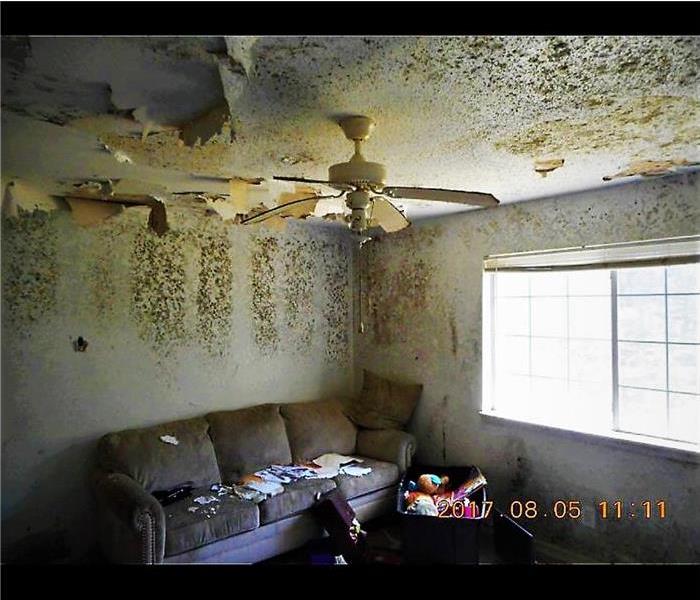 The apartment was sure there was a smell coming from a building, I think it might be some Mold growth. Need a Mold removal company? Here we are.
The apartment was sure there was a smell coming from a building, I think it might be some Mold growth. Need a Mold removal company? Here we are.
Tennet says there is an odd moldy smell coming from the Walls in an Apartment Complex
Mold or growth as we call it here at SERVPRO of North Central Mesa can be very hazardous although not all mold is equal.
No two mold jobs are alike, no two Fire jobs are alike, no two water jobs are alike, neither are forensic, biohazards, or hoarding cleanup jobs none are just the same as the one before it.
Before shows like A&E "Hoarders" or "Buried Alive," hoarding is the relatively unknown mental illness. Reality TV shows the worst-of-the-worst of these situations. TV blows things out of proportion. They want all the eye's on their show and don't want you to look away for even an instant. It's like a train wreck; they want to show the gross parts just enough to keep your interest.
So really how accurate are all these different shows? Most will agree to watch a tv show documenting a crew attempt to clean out a disaster scenario is not an accurate depiction of what goes into jobs such as storm or water damage that was left untouched and has cause mold growth, or the most common area of mold growth, the bathroom, from lack of proper ventilation.
Hoarders come in all shapes and sizes, involving many different types of items from trash to treasures, like rare books and other contents.
You can find a hoarder in any place from the cheapest apartments in town to the most expensive neighborhoods. If your friends, family, and loved ones have a hoarding problem and you need someone to come trash out the place for you to start from square one, you know who to call. The water damage restoration company SERVPRO of North Central Mesa.
Water damage creates a perfect breeding ground for mold growth.
8/14/2018 (Permalink)
With all of the storms we have been having lately we have been inundated with water damage jobs and a lot of Restoration companies in the Mesa, AZ area are backlogged. If you are having to wait for someone to come to take care of your water damage areas the is a good chance that mold growth can occur and create a larger, more serious issue. Mold and mildew can start forming in as little too 24 to 48 hours. Make sure to keep the area as clean and ventalated as possible. Keep in mind that just because you don't see mold, doesn't mean it's not there.
If there has been more than 24 to 48 hours that the water damage was discovered or tended to you really should consider having a hygentist come out and perform a mold inspection.
Mold Removal vs. Mold Remdiation
5/22/2018 (Permalink)
Interesting Fact! In the Mesa AZ area, On average, there are about the same number of searches per month on Google for "mold removal" and "mold remediation." (Around 20) As marketers with SERVPRO of North Central Mesa, Kevin and I sometimes get asked what the difference is between "mold removal" and "mold remediation." The answer is quite simple. They are pretty much the same thing.
In reality, it is nearly impossible to remove all mold in a particular area. That's not a bad thing. Mold in and of itself is not bad as we generally have it thought out in our heads. For example, Some molds are used to make some delicious types of cheese. Mold generally becomes a problem when it starts to grow on surfaces inside buildings. But outdoors, we encounter mold spores almost on a continual basis.
Inside exposure to mold is most dangerous to small children, those with severe respiratory issues, and those with weakened immune systems (for example someone receiving chemotherapy to treat cancer.) It should also be noted, that in some cases exposure to mold can lead to the development of asthma.
According to the American Industrial Hygiene Association, the three main contributing factors to mold growth are humidity, temperature, and poor ventilation.
The 5 best way to avoid the development of mold are (Better Homes and Gardens):
- Use dehumidifiers, fans, and open windows to help reduce the moisture in your home. Be especially vigilant during hot, humid months.
- Fix plumbing leaks as soon as possible.
- Do what you can to prevent rainwater from seeping into your home. Check potential problem areas regularly.
- Clean the fabrics in your home routinely and keep them dry.
- Store items in dry, well-ventilated areas.
Mold Remediation in Fountain Hills AZ
5/15/2018 (Permalink)
Fountain Hills Vacation Home
A home in Fountains Hills Arizona had a small leak, and it went unnoticed until the homeowners saw it coming from out of the building's foundation. It took them a while to turn off the water going to the house. Once that had finally shut it off, thousands of gallons of water must have been in this house to cause this mold damage. It also must have been going on for at least a couple of weeks.
If there is ever a disaster in your home, you know who to call. SERVPRO of North Central Mesa is Faster to any size disaster in order to make it "Like it never even happened." Just give us a call at (480) 553-7103 and we will have our crew mobilized in seconds to help you and your family's home get back to working order.
Do you have a Mold issue? Don't know what it is? We can handle any size disaster. Just give us a chance.
Fountain Hills Vacation Home
12/7/2015 (Permalink)
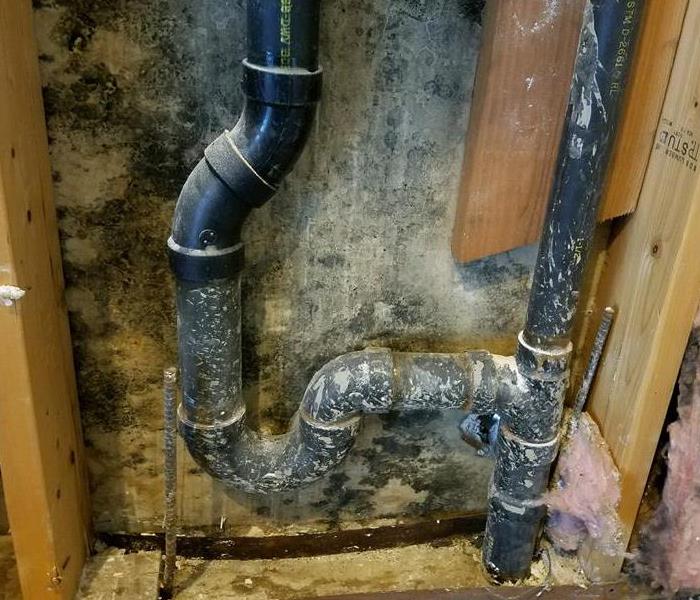 Fountain Hills Mold. A vacation home that was not watched properly.
Fountain Hills Mold. A vacation home that was not watched properly.
A home in Fountains Hills Arizona had a small leak, and it went unnoticed until the home owners saw it coming from out of the building's foundation. It took them a while to turn off the water going to the house. Once that had finally shut it off, thousands of gallons of water must have been in this house to cause this mold damage. It also must have been going on for at least a couple of weeks.
If there is ever a disaster in your home, you know who to call. SERVPRO of North Central Mesa is Faster to any size disaster in order to make it "Like it never even happened." Just give us a call at (480) 553-7103 and we will have our crew mobilized in seconds to help you and your family's home get back to working order.
Mold issue? Don't know what it is? We can handle any size disaster. Just give us a chance.






 24/7 Emergency Service
24/7 Emergency Service
